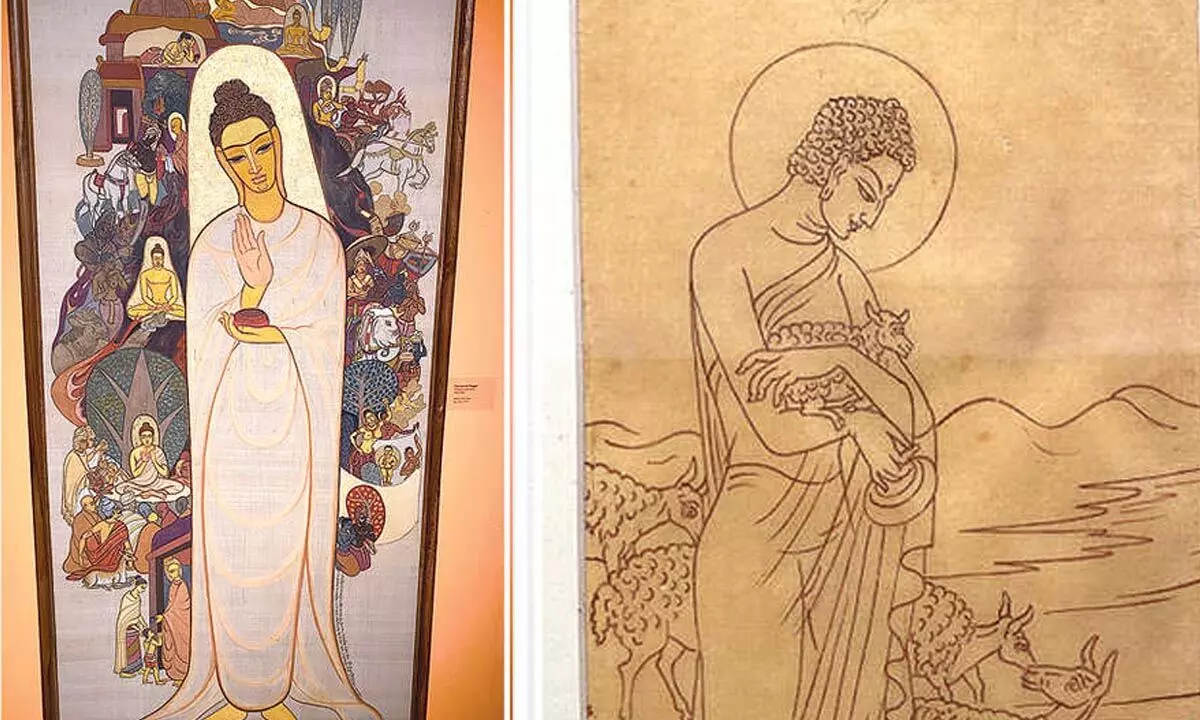Contribution of Bharat art to communicate life of Buddha

The exhibition “Buddham Saranam Gacchami” organised by the National Gallery of Modern Art, New Delhi, showcases the artworks of iconic Bharat artists, including Nandalal Bose, who have explored the life and teachings of Buddha and his spiritual path through line drawings with an ethereal quality
The exhibition “Buddham Saranam Gacchami” organised by the National Gallery of Modern Art, New Delhi, showcases the artworks of iconic Bharat artists, including Nandalal Bose, who have explored the life and teachings of Buddha and his spiritual path through line drawings with an ethereal quality. Born in 1882 in Kharagpur, Munger, Bengal Presidency, British India, Bose was known for his “Bharat style” of painting, synthesizing various art traditions, including folk art, Pahari miniatures, and Ajanta murals. Influenced by Japanese art and techniques, Bose reflected his identity and politics, addressing social ills and promoting Bharat culture.
Nandalal Bose’s artworks showcase indigenous modes of expression, blending traditional Bharat themes, motifs, and techniques. His “Bharat style” reflects his identity and promotes Bharat culture. His use of bold lines, flat colors, and simplified forms contributed to the development of modern Bharat art and created a visual and cultural national identity for India. His paintings celebrated the spirit of Bharat life and indigenous traditions, separating him from the British colonial academic painting style.
Bharat art in Buddhism dates back to the 3rd century BCE, during the reign of Mauryan emperor Ashoka. The art of this period consisted of rock-cut caves, stupas, intricate sculptures, and paintings depicting Buddhist themes. These artistic creations served as visual representations of Buddhist teachings and propagated the religion among the masses. As Buddhism spread throughout India and the world, its art evolved to reflect local cultures and traditions. This fusion of local artistic styles with Buddhist themes resulted in diverse and vibrant forms of art that continue to be celebrated today.
Traditional art forms, such as sculpture, painting, and architecture, depict key moments in Buddha’s life, providing a tangible connection to the enlightened one. Modern art inspired by Buddha’s life captures his teachings and spiritual journey through various mediums, such as abstract paintings representing Buddha’s enlightenment and sculptures using innovative techniques to depict Buddha’s serenity and inner peace.
The early use of art in Buddhist shrines and cave temples significantly communicated Buddhism’s principles and teachings. The decorative motifs and sculptural representations created a visually captivating atmosphere and effectively conveyed core principles like impermanence, compassion, and enlightenment. Bharat art significantly influenced local artistic traditions, as Buddhism spread across Asia, introducing Bharat elements into local cultures.
Symbols and imagery in Bharat art can effectively convey Buddhist concepts and ideas through symbols and visual elements. Common symbols include the lotus flower, symbolizing purity and enlightenment, and the dharma wheel, representing Buddha teachings and the path to liberation. Bharat artists have effectively communicated core Buddhist concepts through sculptures, paintings, and architectural designs, showcasing compassion, meditation, and the path to enlightenment.
Bharat Buddhist art is a significant form of art that has been instrumental in conveying the teachings and principles of Buddhism. It uses iconography, which involves the use of deities, figures, and symbols to communicate complex philosophical concepts and spiritual ideas. This art form also serves as a guide for practitioners, aiding in meditation and deepening their understanding of Buddhist principles.
Narrative art has also played a significant role in the dissemination of Buddhist stories and teachings through visual representations, such as the Jataka tales. These tales, enriched with moral lessons, were skillfully translated into sculptures and paintings, making these stories accessible to both literate and illiterate individuals. The skillful use of symbols and metaphors in narrative art makes complex philosophical concepts visually appealing and easily understandable, contributing to the spread of Buddhist values and beliefs across different cultures and generations.
Bharat art has also played a crucial role in depicting important events in Buddha’s life, such as the Great Stupa of Sanchi and the Ajanta Caves. These works capture important events and serve as a means of spreading Buddhist teachings and principles to a wider audience. Bharat art, including sculpture, painting, and architecture, served as powerful vehicles for communicating the principles and messages of Buddhism. Through intricate carvings and elaborate murals, artists skillfully depicted the life and teachings of Buddha, attracting the attention and curiosity of the masses.
The influence of Bharat art on the spread of Buddhism cannot be overstated, as ancient India’s artforms, including sculpture, painting, and architecture, served as powerful vehicles for communicating the principles and messages of Buddhism. The aesthetically pleasing and spiritually evocative nature of Bharat art captures the essence of Buddhism and conveys its teachings to both the illiterate and the learned, making it a potent tool for religious propagation.
In Southeast Asia, Bharat art played a crucial role in communicating Buddhism through its adaptation and assimilation. Influenced by trade, missionary activities, and political connections, Bharat art forms, such as sculpture and architecture, were introduced to the region and adapted to local artistic traditions. This fusion of Bharat and local elements resulted in unique styles, showcasing a remarkable fusion of cultures.
Contemporary artists have reinterpreted Bharat Buddhist art, blending traditional aesthetics with modern sensibilities to create captivating artworks that communicate the essence of Buddhism in a contemporary context. They use innovative materials and techniques to reimagine traditional Buddhist symbols, fostering a dialogue between ancient wisdom and contemporary artistic practices. This has significantly impacted Buddhism’s communication and accessibility, particularly in the Western world.
In conclusion, Bharat art has significantly influenced Buddhism, spreading teachings, and shaping religious and cultural ideologies. By integrating traditional Buddhist symbols, motifs, and stories, modern artists have made the religion more accessible and relatable to a diverse audience, promoting a more harmonious and inclusive world.















